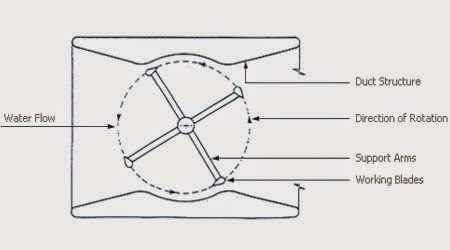If you are curious on the derivation of the 59% efficiency see this link: http://www.wind-power-program.com/betz.htm
Specific Types of Turbines:
- 'The Saphonian'- claims to be able to overcome the Betz Limit. Bladless. "Wind drives pistons which are then converted into mechanical energy. Hydraulic pressure is then produced and converted into electricity using a hydraulic motor and generator. " http://www.saphonenergy.com
- Tesla- blade-less turbine, utilizes energy from fluids
- Tesnik- business closed due to lack of funding. Based on Tesla Turbine- extracting wind power from adhesion, drag, and lift. It is a vertical axis turbine. Contains more than 200 disks stacked one on top of each other with a gap between. Airflow enters in the gaps and adheres to the surface which contributes to the rotation of the rotor.
Vertical Axis Turbines:
2 main types:
- Savonius rotor: crude, low-tech, inefficient
- Darrieus model : looks like an egg beater
- two vertically oriented blades revolving around a vertical shaft
- uses airfoil design (which can only be 59.3% efficient)- like an airplane wing, has a flat side and a curved side, creating lift. Airfoils are secured to a hub which is attached to a generator shaft, creating rotational momentum spinning the generator.
Windspire
Arborwind
Synasphere
WePower
Quiet Revolution
Architectural Wind
WePower
Quiet Revolution
Architectural Wind
Hydro-
- for rivers and tidal currents
- with vertical hydrofoil blades-
- hydrodynamic lift principle: can move faster than the speed of surrounding water
- new revolution in blade technology (also applies to wind turbines)
- tubercles technology based off of the fins of Blue Whales
- Blue Energy
- Gorlov Helical Turbine
Benefits of Vertical Axis Turbines:
- Because main rotor shaft is set vertically, the main components are located at the base of the turbine making the generator and gearbox easier to service and repair.
- Can be packed closer together in wind farms (more in a given space)
- quieter for efficiency
- produce lower forces on support structure
- but blades are prone to fatigue due to the variation of forces applied during rotation
- modern materials, although expensive, solve this issue
- Omni-directional
- don't need wind-sensing and orientation mechanisms
- Horizontal turbines are often found in wind farms and places where acting shifting winds does not matter
- helps to overcome the poor reliability of turbines when winds fall or fail; overcomes poor performance in unsteady or turbulent air (think urban environments)
- Do not require as much fluid motion to generate power
- For wind-can be closer to the ground where wind speed is lower (can place on chimneys (wind farms on top of buildings))
- Better in gusty winds like those found in many urban environments
Drawbacks
- Omni-directional = good! But, only one surface is facing the wind at one time (different in water)
- Centrifugal force
- in horizontal turbines the greatest force is on the part of the blade nearest to the hub, which is the strongest part of the turbine. In vertical turbines, the strongest forces are at the center, not at the ends where the blades are attached.
- making the blades straight distributes these forces more evenly
- however you have to take into account torque variation and huge bending movements on the blades. Helical twisted blades avoid these torque issues.
- can also beef up the blades to protect them but this requires more materials, labor, weight, and money
- Turbulence! = wear on turbine
- lots of turbulence in urban environments due to the way fluids are effected by buildings
- Expensive, although all turbines are
Tesla Turbine:
- patented by Nikola Telsa (hence the name) (it was his favorite invention)
- blade-less turbine that uses the boundary layer effect
- consists of air hose, 2 air inlets, front and rear cover and 5 exhaust ports, disks with holes in center
- turbine is vertical and as air enters it creates a vortex due to the shape of the inside
- as the air passes the disks they create drag that pulls the disks with them. Centrifugal force created by the spinning disks is trying to force the air outwards, but the air can only exit through the exhaust ports. Speed of disks becomes equal to the speed of airflow.
- turbine can also function as a pump
--------------------
Gorlov helical water turbine:
--------------------------------------------Gorlov helical water turbine:
- evolved from Darrieus design
- vertical axis
- helical blades/foils
- blades curve around the axis- sum of lit and drag forces on blade do not change with changing angles
- 35% efficient in energy capture
- damless hydro technology
- claimed that it spins slowly enough so that fish can see it and react to it and thus not be killed by it
BLADE DESIGN IDEAS:
Vertical axis turbine blade design:
Gorlov Design:



Our Designs
Below is the first design iteration of the combination Tesla-Gorlov design (18/11/14)
 |
| Three blade savonius design |
 |
| Three blade basic Gorlov helical design (modified from a document on GrabCad) |
GEARING RATIOS- http://science.howstuffworks.com/transport/engines-equipment/gear-ratio.htm





















No comments:
Post a Comment